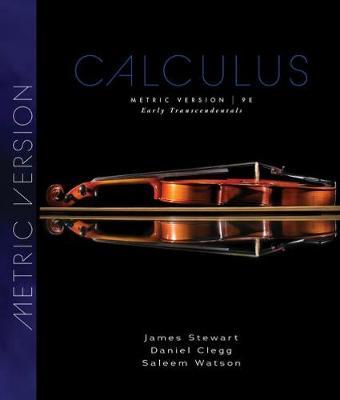Full Product Details
Author: James Stewart (McMaster University) ,
Daniel K. Clegg (Palomar College) ,
Saleem Watson (California State University, Long Beach) ,
Daniel K. Clegg (Palomar College)
Publisher: Cengage Learning, Inc
Imprint: Brooks/Cole
Edition: 9th edition
Dimensions:
Width: 22.60cm
, Height: 25.60cm
, Length: 5.00cm
Weight: 2.926kg
ISBN: 9780357113516
ISBN 10: 0357113519
Pages: 1408
Publication Date: 24 March 2020
Audience:
College/higher education
,
Tertiary & Higher Education
Format: Hardback
Publisher's Status: Active
Availability: In Print

This item will be ordered in for you from one of our suppliers. Upon receipt, we will promptly dispatch it out to you. For in store availability, please contact us.
Author Information
James Stewart received the M.S. degree from Stanford University and the Ph.D. from the University of Toronto. After two years as a postdoctoral fellow at the University of London, he became Professor of Mathematics at McMaster University. His research has been in harmonic analysis and functional analysis. Stewart’s books include a series of high school textbooks as well as a best-selling series of calculus textbooks published by Cengage Learning. He is also co-author, with Lothar Redlin and Saleem Watson, of a series of college algebra and precalculus textbooks. Translations of his books include those into Spanish, Portuguese, French, Italian, Korean, Chinese, Greek, Indonesian and Japanese. A talented violinist, Stewart was concertmaster of the McMaster Symphony Orchestra for many years and played professionally in the Hamilton Philharmonic Orchestra. He has given more than 20 talks worldwide on mathematics and music. Stewart was named a Fellow of the Fields Institute in 2002 and was awarded an honorary D.Sc. in 2003 by McMaster University. The library of the Fields Institute is named after him. The James Stewart Mathematics Centre was opened in October, 2003, at McMaster University. Daniel Clegg received his B.A. in Mathematics from California State University, Fullerton and his M.A. in Mathematics from UCLA. He is currently a professor of mathematics at Palomar College near San Diego, California, where he has taught for more than 20 years. Clegg co-authored BRIEF APPLIED CALCULUS with James Stewart and also assisted Stewart with various aspects of his calculus texts and ancillaries for almost 20 years. Saleem Watson received his bachelor of science degree from Andrews University in Michigan. He completed his graduate studies at Dalhousie University and McMaster University, where he received his Ph.D. Dr. Watson conducted subsequently research at the Mathematics Institute of the University of Warsaw in Poland. He taught mathematics at Pennsylvania State University before serving at California State University, Long Beach, where he is currently professor emeritus. Dr. Watson's research encompasses the field of functional analysis. Dr. Watson is an important co-author for Dr. Stewart's best-selling calculus textbook series as well as his popular precalculus, college algebra and trigonometry texts.



